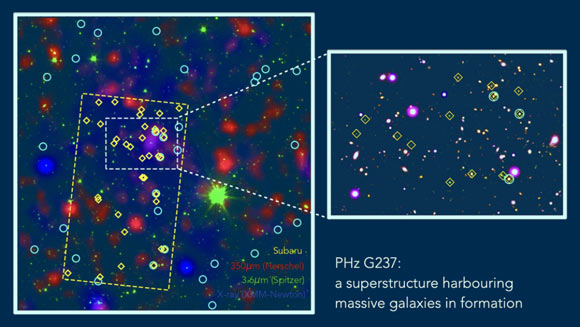The newly-discovered protocluster, named PHz G237.01+42.50 (G237 for short), contains over 60 members, including blue star-forming galaxies and active galactic nuclei. G237 is so far away that its light traveled for more than 10.6 billion years.

Several instruments joined forces to produce this image of the G237 protocluster, identifying its galaxies in different colors representing different wavelengths of observations. The image on the right zooms in on the central region of G237. Image credit: ESA / Herschel / XMM-Newton / NASA / Spitzer / NAOJ / Subaru / Large Binocular Telescope / ESO / VISTA / Polletta et al. / Koyama et al.
“This discovery is an important step toward reaching our ultimate goal: understanding the assembly of galaxy clusters, the most massive structures that exist in the Universe,” said Dr. Brenda Frye, an astronomer with the Steward Observatory at the University of Arizona.
Initially discovered by ESA’s Planck telescope as part of an all-sky survey, G237 showed up prominently in the far-infrared region of the electromagnetic spectrum.
The observations looked promising, but to confirm its identity required follow-up observations with other telescopes.
Dr. Frye and her colleagues conducted observations using the combined power of the Large Binocular Telescope in Arizona, and the Subaru Telescope in Japan.
The astronomers identified a total of 63 galaxies belonging to the G237 protocluster.
“You can think of galaxy protoclusters such as G237 as a galaxy shipyard in which massive galaxies are being assembled, only this structure existed at a time when the Universe was 3 billion years old,” Dr. Frye said.
“At the same time, the genealogy may be closer than you think. Because the Universe is homogeneous and the same in all directions, we think that the Milky Way may have docked at a protocluster node similar to G237 when it was very young.”
At first, observations of G237 implied a total star formation rate that was unrealistically high, and the team struggled to make sense of the data.
The G237 protocluster seemed to be forming stars at a rate of 10,000 times that of the Milky Way.
At that rate, the protocluster would be expected to rapidly use up its stellar fuel and subsequently settle down into a complex system similar to the Virgo supercluster.
“Each of the 63 galaxies discovered so far in G237 was like a star factory in overdrive,” Dr. Frye said.
“It’s as if the galaxies were working on overtime to the assemble stars. The rate of production was unsustainable. At such a pace, the supply chains are expected to break in the near future, and in a way that permanently shuts down the galaxy shipyard.”
Such high yields could only be maintained by a continuous injection of fuel, which for stars is hydrogen gas.
“This would require an efficient and unbroken supply chain that drew in unreasonably large amounts of fresh gas to fuel the star-forming factories. We don’t know where that gas was coming from,” Dr. Frye said.
Later, the researchers discovered that some of what it was seeing came from galaxies unrelated to the protocluster, but even after the irrelevant observations were removed, the total star formation rate remained high, at least 1,000 solar masses per year. In comparison, our own Milky Way Galaxy produces about one solar mass each year.
“The picture we have pieced together now is that of a successful galaxy shipyard, which is working at high efficiency to assemble galaxies and the stars within them and has an energy supply that is more sustainable,” Dr. Frye said.
The findings were published in the journal Astronomy & Astrophysics.
_____
M. Polletta et al. 2021. Spectroscopic observations of PHz G237.01+42.50: A galaxy protocluster at z = 2.16 in the Cosmos field. A&A 654, A121; doi: 10.1051/0004-6361/202140612







